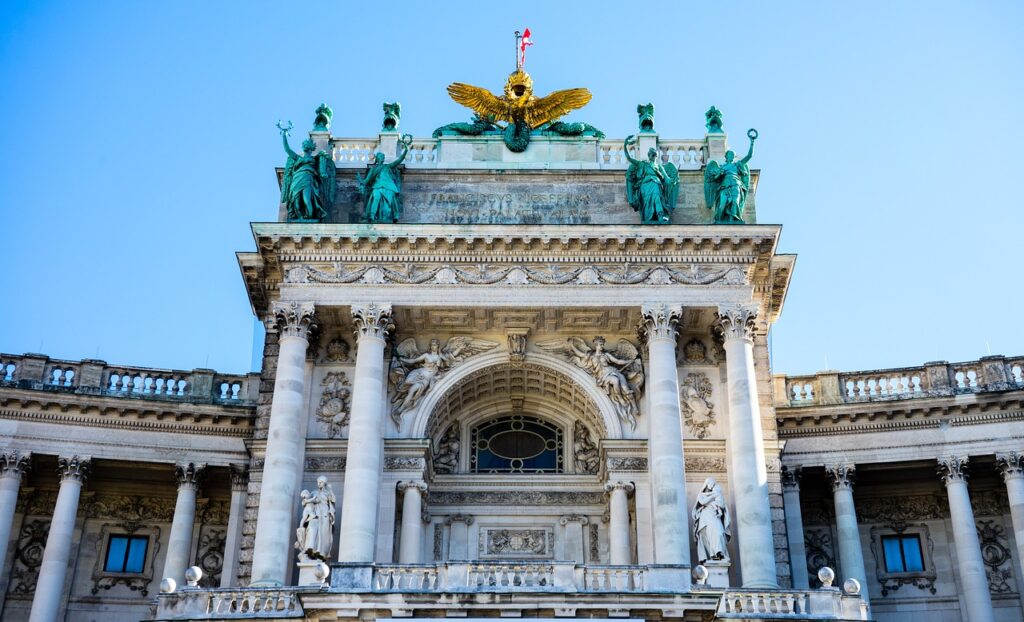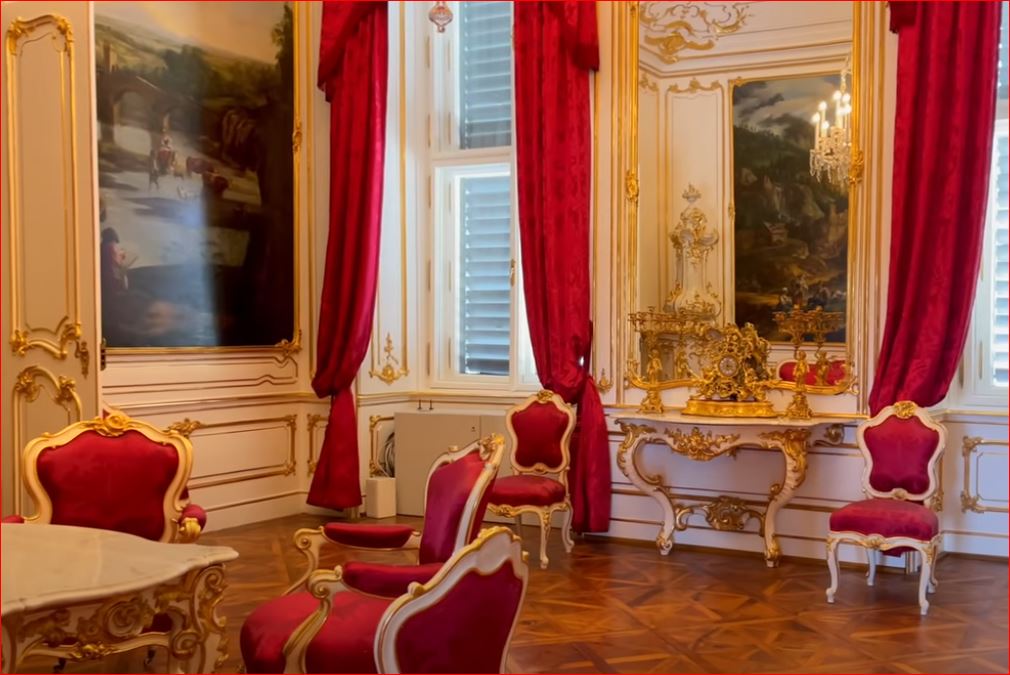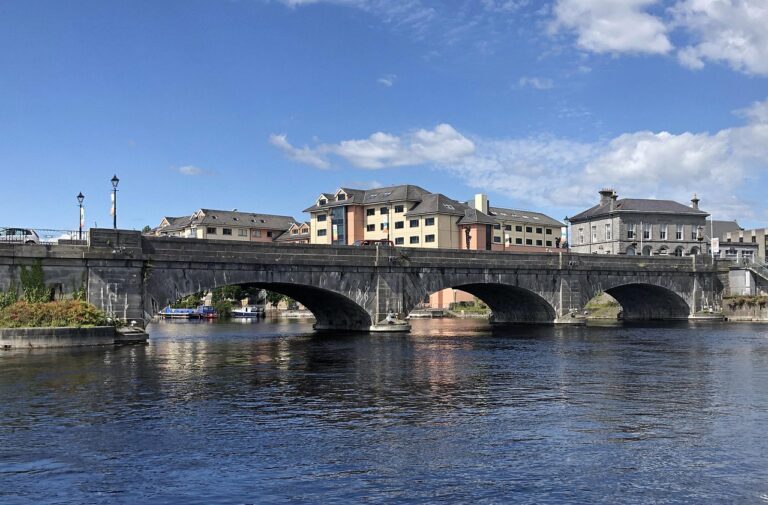Table of Contents
ToggleThe Hofburg & Sisi Museum in Vienna: Austria’s Historical Heart
The Hofburg & Sisi Museum in Vienna is a monumental symbol of Austria’s historical heritage. For over 600 years, it was the political center of the Austrian monarchy, serving as the residence of the Habsburg Family. Today, it houses the Sisi Museum, dedicated to the life of Empress Elisabeth of Austria (known as Sisi), along with the Imperial Apartments and the Silver Collection. A guided tour through the palace allows you to explore these stunning spaces, including the gardens and courtyards, providing a glimpse into the grandeur of Austria’s royal past.
Exploring the Grandeur of Royal Vienna
Imagine walking through the very halls where Austrian royalty once resided. The Hofburg & Sisi Museum in Vienna takes you back in time, offering an immersive look into the lives of the Habsburgs and the rich culture of Vienna. From the impressive Imperial Apartments to the personal history of Sisi, this iconic palace reveals stories that span centuries.
Although Schonbrunn Palace and Hofburg Palace were both key residences of the Habsburg Family, each offers a distinct experience. Schonbrunn is famous for its summer residence, ideal for taking in magnificent views and gardens, while the Hofburg Palace invites visitors to immerse themselves in the history and culture that shaped Vienna. A visit to Hofburg Palace provides a deep dive into the monarchy’s legacy, making it an essential stop on your journey through Vienna.
Don’t miss out on the chance to explore the Hofburg Palace and Sisi Museum! Book your guided tour today and step into the captivating history and beauty of Vienna’s royal past!
The Habsburg Legacy Behind the Palace Walls

Stepping into the Hofburg Palace isn’t just about admiring beautiful rooms or marveling at Imperial décor — it’s about walking through the powerful shadows of the House that shaped Europe. The Habsburgs, whose name came from a castle built in present-day Switzerland, ruled vast lands for centuries. While exploring the Sisi Museum, I felt a deeper connection to the monarchy as I learned how the Empire evolved. From 1452, when the Habsburgs began leading the Holy Roman Empire, to their extinction in the male line in 1740, their impact remained carved into every corner of the palace. You’ll see portraits of kings, rare pieces from Galicia, and décor reminiscent of their reign in Portugal, Hungary, and Italy.
As you move through the Imperial Apartments, you sense how this family didn’t just influence Austria, they ruled several principalities — from Bohemia and Croatia to the Netherlands. What struck me most was how this one fortress of power eventually produced rulers across colonies and reshaped the continent. The transition from being mere rulers in the 13th century to becoming emperors in 1806, then formally ending the monarchy in 1918, is a timeline woven directly into Hofburg’s walls. Each exhibit, especially those tied to Austria’s royal history, shows how the Habsburgs reigned, became symbols of power, and even helped produce legacies still admired today. It’s not just history — it’s an immersive, storied experience that makes you feel like you’ve time-traveled through centuries.
A Living Fortress Through the Centuries

When I visited Hofburg, I wasn’t just stepping into a tourist attraction — I was entering a place where history breathes through every corner. Originally a medieval castle from the 13th century, this fortress still holds its core structure, though much has been altered over the centuries. Walking through the courtyards, under the shadows of the remaining towers, and imagining the old moat and drawbridge that once protected it, I could feel the passage of time. The façade was redesigned in the 16th century into a Renaissance style, adding elegance to the once strictly defensive complex.
The Palace is massive — made up of 18 wings, 19 courtyards, and about 2,600 rooms. I was surprised to learn that around 5,000 people still work and live here today. Though I had made a mental note to see the Imperial Treasury, it was closed that day. But right nearby, I did explore the Austrian National Library, which felt like a scene straight out of Beauty and the Beast — grand, gold-accented shelves, and quiet magnificence. The entire complex is more than a monument; it’s a blend of old-world charm and living history.
The last royal occupant of this magnificent structure was Emperor Franz Joseph, who passed on November 21, 1916. I found it fascinating that someone we read about in history books lived in these rooms. Being inside the same halls where he walked gave me a stronger connection to Austria’s imperial past. This isn’t just a preserved memory — it’s a living court, evolving, yet grounded in its majestic roots.
The Timeless Elegance of the Silver Collection
Walking into the Silver Collection at the Hofburg Palace felt like stepping into a world where elegant dining was a form of art. The first thing I noticed were the gleaming forks, knives, and plates, arranged with stunning precision. But it wasn’t just about the dinnerware — some centerpieces stretched nearly 100 feet long (about 30 meters), designed to impress at every royal banquet. I learned that this collection includes around 150,000 historical items, though only about 7,000 are on display today. The experience gave a deep insight into the dining culture of the Habsburg court, with luxurious linen settings and sparkling silver fixtures from centuries past.
Digging deeper, I found that the role of Silver Chamberlain was first mentioned during the reign of Frederick III and Maximilian I, showing how vital these traditions were. Chamberlain wasn’t just responsible for table settings — his role grew to oversee the Court Kitchen, Court Confectionery, Court Linen Room, Court Cellars, Court LightRoom, Court Silver and Table Room, and even the Court Depot of Victuals, Coal Depot, and Firewood supplies. These former offices, now transformed into exhibition spaces, offer a rare look into how the royals dined and hosted events. Today, many of these items are used occasionally for state functions, although they are no longer part of daily court life. I was genuinely fascinated by how a simple Room could capture such a prominent piece of royal legacy through time, function, and ritual.
Exploring the Life of Empress Elisabeth

When you visit the Sisi Museum in Vienna, you are stepping into the world of Empress Elisabeth (known as Sisi), where over 300 personal items tell the story of her life. This museum offers an exceptional view of her personality and experiences, providing a deeper look beyond the fairytales of her life often depicted in the famous 1950s Sissi film series. While those films show her life like a fairytale, the truth is far more complex. The museum walks you through her unconventional upbringing, her early marriage to Emperor Franz Joseph I at just sixteen, and her later life in the royal court.
Among the fascinating displays are items such as jewelry, fans, gloves, and even a medicine chest that includes her cocaine syringe. There are also reconstructed dresses, including her summer dress from her wedding day and her Hungarian coronation dress, giving you a glimpse into her style and elegance. The display showcases how slender she was — standing at 5’8″ and weighing only between 98 and 101 pounds, possibly due to her strict dieting, exercise, and emotional challenges like depression. Seeing these items helps you understand the pressures of her royal life and how she worked to maintain her appearance, making her beauty her top priority.
A Glimpse into Sisi’s Beauty Routine
Empress Sisi is remembered not just for her royal status but for her remarkable beauty. Her appearance was her top priority, and she made sure that every aspect of her physical appearance was meticulously maintained. Her bed chamber was equipped with exercise equipment, including balance beams, so she could work on her body every morning. The tour of her rooms showed the several ways she tried to keep herself in shape, from her strict exercise regime to riding horses for hours.
What struck me was how much time she dedicated to her hair. Her daily routine took about 3 hours, which she wisely used to learn languages while her hair was being done. It’s clear that for Sisi, beauty was not just a matter of appearance, but a priority in her life. As someone who has struggled with maintaining my own exercise routine, I was impressed by her dedication to keeping her looks at their best. Fencing was also part of her regimen, showing that her commitment to her appearance went beyond just dieting — it was about an overall lifestyle.
The Royal Experience at the Imperial Apartments
The Imperial Apartments in Vienna offer an exceptional glimpse into the private world of Emperor Franz Joseph and Sisi. The tour takes you through 24 rooms, each telling a unique story of their life. You’ll see private rooms, including a reception room and dining room, which were once filled with the sounds of court life. These rooms are carefully curated with a focus on historical authenticity, showcasing furniture and fittings that mostly date back to the second half of the 19th century. As you walk through, you’ll notice that the ceramic stoves and chandeliers remain from the 18th century, highlighting the blend of eras that define the palace.
The attention to detail in maintaining the original wares is truly impressive. For example, the chandeliers once held candles, but as electricity was introduced, they were adapted to fit the changing times. The furniture and fittings not only represent the lifestyle of the royal couple but also the evolving history of the palace. It’s fascinating how the curators have managed to preserve the spirit of the original design while incorporating modern conveniences as time progressed. The palace feels like a living piece of history, where the past and present coexist beautifully.
These rooms are more than just living spaces; they are a testament to the authenticity of royal life. The fittings in the Imperial Apartments bring you closer to the royal family’s daily existence, and the historic ambiance is a reminder of how those who once lived there shaped the culture of Vienna. The mix of 19th-century style with older 18th-century elements makes for a truly immersive experience. If you visit Vienna, this part of the Hofburg Palace is an absolute must-see for anyone interested in the imperial history of Austria.
The Legacy of Empress Elisabeth

The legacy of Empress Elisabeth, known as Sisi, is deeply embedded in the history of Vienna, and her story is one of both grandeur and tragedy. At the Hofburg & Sisi Museum in Vienna, you can learn about the complexities of her life, from her arranged marriage to Emperor Franz Joseph to her untimely and tragic death. In the 1950s, the film series about her life painted a picture of a royal life that was almost like a movie — full of beauty, love, and idealized moments. However, the truth behind her marriage was far from perfect, as her older sister was originally supposed to marry the emperor, which created tension and turmoil in the royal family.
Her death at the hands of a 25-year-old Italian anarchist, who stabbed her with a needle file that was 4 inches (100 mm) long, is one of the most tragic moments in her legacy. The Sisi Museum does a wonderful job of portraying the reality of her life, showing how Sisi was caught in a web of duty, family expectations, and her struggles. I highly recommend visiting the Hofburg & Sisi Museum in Vienna and viewing the video that accompanies the exhibit, which also includes the history of Schönbrunn Palace, offering more insight into her world. If you’re fascinated by historical figures and want to understand more about Sisi’s real life beyond the fairytales, this exhibit is a must-see.
Ticket Information and Tours
When planning your visit to the Hofburg & Sisi Museum in Vienna, consider getting the Vienna Pass, which offers a convenient sightseeing pass covering entry to both sites along with the Imperial Silver Collection and the Imperial Apartments. The pass also provides tickets in 13 languages, making it accessible for international visitors. If you prefer not to wait in line, you can download the audio guide or the iTunes guide for free, ensuring you get the most out of your visit without any hassle.
For those who want a more structured experience, I highly recommend booking through GetYourGuide Tours. Their tour operators are reliable and affordable, offering guided tours that cover the best of the Hofburg & Sisi Museum in Vienna. Plus, they have a great refund policy if any issues arise, making it a stress-free way to explore Vienna’s rich royal history. Whether it’s summer or any other time of year, these options ensure that your visit to the Hofburg & Sisi Museum in Vienna is both informative and convenient.
Visiting the Hofburg Palace and Sisi Museum
The Hofburg Palace and Sisi Museum are open every day, even on public holidays, giving visitors plenty of opportunities to explore. I recommend checking their website for the most up-to-date opening times before you go. The museum and palace are easy to reach using public transportation. On my trip, I used the hop-on, hop-off bus that comes with the Vienna Pass, but you can also take the underground (U3) and get off at Herrengasse. Alternatively, trams 1, 2, D, and 71 stop at Burgring, and buses 1A and 2A stop right at the Hofburg.
Getting around Vienna is simple, especially with all the convenient routes that take you directly to the Hofburg Palace and Sisi Museum. Whether you’re using the underground or trams, everything is well connected, ensuring you don’t waste any time getting to the historic sites. I found it super easy to navigate the city with the Vienna Pass, and it made my visit even more enjoyable.
conclusion:
Visiting the Hofburg Palace and the Sisi Museum in Vienna is a journey through Austria’s rich royal history. This stunning palace, once home to the mighty Habsburg family, offers an unforgettable glimpse into their world. From the elegant Imperial Apartments to the fascinating Sisi Museum, you’ll explore rooms filled with royal treasures and untold stories, making it a must-see for anyone interested in imperial history. A visit here is more than just a tour; it’s an immersive experience that brings the past to life. The Sisi Museum lets you step into the life of Empress Elisabeth, known as Sisi, offering an authentic look at her legacy. With easy access by public transportation, including trams and the Vienna Pass, it’s simple to reach and perfect for all ages. Don’t miss out on this unique opportunity to immerse yourself in the history and grandeur of Vienna!


















